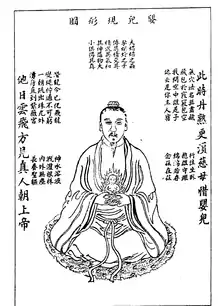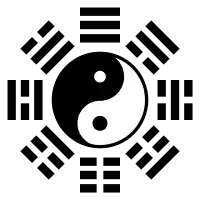| Dantian | |||||||||
|---|---|---|---|---|---|---|---|---|---|
 1615 illustration of the neidan meditation Ying'er xianxing (嬰兒現形, Generating the [Inner] Infant) in the Lower Dantian | |||||||||
| Chinese name | |||||||||
| Chinese | 丹田 | ||||||||
| Literal meaning | elixir-of-life field | ||||||||
| |||||||||
| Vietnamese name | |||||||||
| Vietnamese | Đan điền | ||||||||
| Chữ Hán | 丹田 | ||||||||
| Thai name | |||||||||
| Thai | ตันเถียน | ||||||||
| RTGS | dantian | ||||||||
| Korean name | |||||||||
| Hangul | 단전 | ||||||||
| Hanja | 丹田 | ||||||||
| |||||||||
| Japanese name | |||||||||
| Kanji | 丹田 | ||||||||
| Hiragana | たんでん | ||||||||
| |||||||||
| Part of a series on |
| Taoism |
|---|
 |
| This article is part of a series on |
| Alternative medicine |
|---|
 |
Dantian is a concept in traditional Chinese medicine loosely translated as "elixir field", "sea of qi", or simply "energy center". Dantian are the "qi focus flow centers", important focal points for meditative and exercise techniques such as qigong, martial arts such as tai chi, and in traditional Chinese medicine.[1][2]
Overview
Historically the first detailed description of the lower Dantian is in the Laozi zhongjing from the 3rd century CE, which refers to the elixir-of-life field where "essence" and "spirit" are stored; it is related to regeneration and sexual energy, menstruation and semen.[3] Traditionally, a dantian is considered to be a center of qi or life force energy.[1][2] The dantian are important points of reference in neidan, qigong, neigong, daoyin, Taoist sexual practices, reiki[4] and other self-cultivation practices of exercise, breathing, and meditation, as well as in martial arts and in Traditional Chinese medicine. The lower dantian is particularly important as the focal point of breathing technique as well as the centre of balance and gravity. Dantian are focal points for transmutation of the three treasures jing, qi and shen. Qi can be seen as a substance when it is stored in the form of jing, this can be refined by heating in these cauldrons into more rarefied states such as qi which is insubstantial and further still into shen which is more like the Western concept of mind although it is more often translated as "spirit".[5]
Taoist and Buddhist teachers often instruct their students to centre the mind in the navel or lower dantian. This is believed to aid control of thoughts and emotions. Acting from the dantian is considered to be related to higher states of awareness including sanmei (三昧) or ding (定).
Three dantians
Different schools of thought categorize dantian in various manners. Three main dantian are typically emphasized:[1][2]
- Lower dantian (下丹田, Xià Dāntián): at the crossing of the horizontal line behind the Ren-6 acupoint and vertical line above the perineum, which is also called "the golden stove" (金炉 pinyin: Jīn lú) or the namesake "elixir-of-life field" proper, where the process of developing the elixir by refining and purifying essence (jing) into vitality (qi) begins.[6]
- Middle dantian (中丹田, Zhōng Dāntián): at the level of the heart, which is also called "the crimson palace", associated with storing spirit (shen) and with respiration and health of the internal organs, in particular the thymus gland. This cauldron is where vitality or qi is refined into shen or spirit.[7]
- Upper dantian (上丹田, Shàng Dāntián): at the forehead between the eyebrows or third eye, which is also called "the muddy pellet", associated with the pineal gland. This cauldron is where shen or spirit is transmuted into wu wei or emptiness.[5][8]
Importance of the lower dantian
The term dantian used by itself usually refers to the lower dantian, which is considered to be the foundation of rooted standing, grounding, breathing, and body awareness in Chinese and other martial arts including qigong. The lower dantian has been described to be "like the root of the tree of life."[2]
In speaking of the lower of the three energy centers, the term dantian is often used interchangeably with the Japanese word hara (腹; Chinese: fù) which means simply "belly." In Chinese, Korean, and Japanese traditions, it is considered the physical center of gravity of the human body and is the seat of one's internal energy (qi). A master of Japanese acupuncture,[9] calligraphy, swordsmanship, tea ceremony, martial arts, among other arts, is held in the Japanese tradition to be "acting from the hara."
The lower dantian in Chinese medical theory it corresponds to basic instinct or self preservation as it is connected to primordial essence, Jing one's familial inheritance. The area is associated to the tantric swadhisthana chakra In yoga philosophy, it is thought to be the seat of prana that radiates outwards to the entire body.[10]
See also
- Acupuncture
- Dosha -vatta, pitta, Kapha (3 life elements in body)
- Hara (tanden)
- Jing (TCM)
- Kiai
- Kundalini energy
- Meditation
- Mindfulness (Buddhism)
- Misogi
- Pushing hands
- Qigong
- Scientific skepticism
- Secret of the Golden Flower
- Silk reeling
- Tai chi
- Triple burner
References
- 1 2 3 Yang, Jwing-Ming. (1989). The root of Chinese Chi kung: the secrets of Chi kung training. Yang's Martial Arts Association. ISBN 0-940871-07-6.
- 1 2 3 4 Cohen, K. S. (1999). The Way of Qigong: The Art and Science of Chinese Energy Healing. Random House of Canada. ISBN 0-345-42109-4.
- ↑ Laozi zhongjing (Central Scripture of Laozi), sec. 17. Translation published in Fabrizio Pregadio, "Early Daoist Meditation and the Origins of Inner Alchemy," in Benjamin Penny, ed., Daoism in History: Essays in Honour of Liu Ts'un-yan, 139–40 (London: Routledge, 2006). http://www.goldenelixir.com/taoism/texts_laozi_zhongjing.html
- ↑ "Reiki: (In)frequently asked questions..."
- 1 2 T'ai Chi Ch'uan and Meditation by Da Liu, page 92 – Routledge and Keegan Paul 1987 ISBN 0-14-019217-4
- ↑ Lu K'uan Yu (1970). Taoist Yoga. Rider. p. 10. ISBN 0-7126-1725-6.
This area is associated with the Sea of Qi.
- ↑ "Cinnabar Fields (Dantian)".
- ↑ Jefferson, R. B. (1982). "Chapter 4. The Archaic Anatomy of Individual Organs". Doctrine of the Elixir. Coombe Springs Press. ISBN 0900306157. Full text here
- ↑ Matsumoto, Kiiko; Birch, Stephen (1988). Hara diagnosis: reflections on the sea. Brookline, Massachusetts: Paradigm Publications. ISBN 978-0-912111-13-1.
- ↑ T'ai Chi Ch'uan and Meditation by Da Liu, pages 91–92 – Routledge and Keegan Paul 1987 ISBN 0-14-019217-4
- Chia, Mantak. Cosmic Orbit: Connect to the Universe from Within. Universal Tao Publications, 2005. ISBN 974-85401-4-6.
- Porkert, Manfred. The Theoretical Foundations of Chinese Medicine. MIT Press, 1974. ISBN 0-262-16058-7.
- Rouselle, Irwin. ‘Spiritual Guidance in Contemporary Taoism’. In Spiritual Disciplines: Papers from the Eranos Yearbooks. Princeton University Press, 1960. ISBN 0-691-01863-4.
- Wang, Mu. Foundations of Internal Alchemy: The Taoist Practice of Neidan. Golden Elixir Press, 2011. ISBN 978-0-9843082-5-5.
External links
- Doctrine of the Elixir – On the conception of the Dan Tian in Daoist cosmology.
- "An Shigao and Early Chinese Meditation Techniques" – Phra Kiattisak Kittipanyo (August 2012), DIRI Journal Volume 1, no. 1, pp. 98–118.

